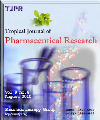
|
Tropical Journal of Pharmaceutical Research
Pharmacotherapy Group, Faculty of Pharmacy, University of Benin, Benin City, Nigeria
ISSN: 1596-5996
EISSN: 1596-5996
Vol. 14, No. 4, 2015, pp. 655-662
|
 Bioline Code: pr15086
Bioline Code: pr15086
Full paper language: English
Document type: Research Article
Document available free of charge
|
|
|
Tropical Journal of Pharmaceutical Research, Vol. 14, No. 4, 2015, pp. 655-662
| en |
Dose Determination of Activated Charcoal in Management of Amitriptyline-Induced Poisoning by Reversed-Phase High-Performance Liquid Chromatography
Alotaibi, Mohammed A.; Fataftah, Amjad K.; Alkhanbashi, Khalid; Al-Dhawailie, Abdlatif A.; Alanazi, Fawaz A.; Khurshid, Fowad M. & Alsultan, Mohammed S.
Abstract
Purpose: To assess the doses of activated charcoal currently used in the management of acute
amitriptyline-induced drug poisoning and explore the possibility of using lower doses.
Methods: Albino male Wistar rats, weighing 200 ± 20 g, were used for the study. The animals were
divided into four groups of eight animals each. The concentration of amitriptyline in rat plasma was
measured by high performance liquid chromatography (HPLC) for dose determination of activated
charcoal. Chromatograms were established with acetonitrile: 70 mM KH2PO4 buffer (60: 40, v/v) solvent
system on an Xterna® ms C18 SUM column (5 μm, 3.9 × 150 mm) and pH was adjusted to 4.5 with
ortho-phosphoric acid. Mobile phase flow rate was 1 ml/min and ultraviolet (UV) detection was at 293
nm. Validation of the method was performed to determine its selectivity, linearity, precision, as well as
limits of detection (LOD) and of quantification (LOQ).
Results: Standard curves were linear, r2 = 0.996, for amitriptyline over the concentration range 10 - 60
ng/ml. Recovery (98.3 to 100.85 %) was in the selected concentration range of 10 - 60 ng/ml. The LOD
and LOQ of the method for amitriptyline were 0.109 and 0.332 μg/ml, respectively. The validated
method was successfully applied to measure plasma concentrations of amitriptyline and to measure the
doses of activated charcoal currently used in the management of acute amitriptyline drug poisoning.
Conclusion: The proposed RP-HPLC method enables determination of amitriptyline with good
separation and resolution of the chromatographic peaks. Validation revealed that the method is
sensitive, accurate and selective. Using half of the standard dose of the activated charcoal gave a
comparable effect to the standard dose in reducing drug concentration in the blood. While, using quarter
of the standard dose of activated charcoal does not have a cleared effect.
Keywords
Amitriptyline; Activated charcoal; Drug poisoning; Reversed-phase high-performance liquid chromatography
|
| |
© Copyright 2015 - Tropical Journal of Pharmaceutical Research
Alternative site location: http://www.tjpr.org
|
|
